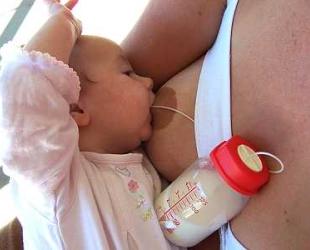Some women with PCOS experience low milk supply. Others have no problems breastfeeding.

Polycystic ovarian syndrome (PCOS) is a problem with hormones that affects 5 to 10% of women during their childbearing years (ages 15 to 45).
Women with PCOS produce higher-than-normal levels of male hormones, resulting in fertility problems, excess body hair, acne, obesity and the increased risk of developing type 2 diabetes.1
PCOS and milk supply
There hasn’t been a lot of research into how PCOS affects breastfeeding. Some women with PCOS may have problems with low milk supply but others have no problem and breastfeed successfully.2,3
Women with PCOS have an increased risk of developing type 2 diabetes later in life. As well, babies born to mothers with PCOS have an increased genetic risk of developing type 2 diabetes. Since breastfeeding helps to protect mums and babies from developing type 2 diabetes later in life, it's important to breastfeed your baby as much as you can.4
Breast changes during pregnancy
Breasts change during pregnancy to prepare for breastfeeding. If you've noticed these changes, then your breasts are probably developing well for breastfeeding. If you haven’t noticed any of these changes you may like to check with your medical adviser or a lactation consultant.
-
Early breast tenderness is common and is often the first sign of pregnancy for many women.
-
Some women notice darkening in colour of their areola / nipple.
-
‘Bumps’ around the areola (called Montgomery’s glands) typically get bigger.
-
Breasts increase in size.5 When this occurs varies from woman to woman, but most women by the end of their pregnancy have noticed some breast growth.
-
Breasts start producing colostrum. Some women can express tiny amounts of this from 16 weeks of pregnancy. Others don’t notice it at all until after their baby is born.
What can I do to make breastfeeding more successful?
There are steps that you can take to increase the likelihood that you can breastfeed.
-
Seek help from a lactation consultant or your doctor
-
Try to use non-medical options for pain relief during labour – TENS, hypnotherapy, water, massage, heat packs, focused breathing.
-
Hold your baby skin-to-skin as soon as possible after birth and then keep baby with you in your room.
-
Feed your baby according to need.
-
Get help if you need, to position and attach your baby correctly.
-
Try to avoid giving your baby supplements unless your doctor says you need to.
-
Try to avoid dummies and bottles.
Medications
If you have problems with low supply, you may find it helpful to speak with your doctor about the use of medications which may help to maximise milk supply.
Supply line
If you have ongoing problems with low milk supply, you may find it helpful to use a supply line which allows your baby to receive any necessary extra milk while still feeding at the breast.
The information on this website does not replace advice from your health care providers.
- Shannon M, Wang Y 2012, Polycystic ovary syndrome: a common but often unrecognized condition. J Midwifery Womens Health 57(3):221-30.
- Marasco L, Marmet C, Shell E 2000, Polycystic ovary syndrome: a connection to insufficient milk supply? J Hum Lact 16(2):143-8.
- Vanky E, IsaksenH, Moen MH, Carlsen SM 2008, Breastfeeding in polycystic ovary syndrome. Acta Obstet Gynecol Scand 87(5):531-5.
- Nesmith H 2006 (November), Polycystic Ovarian Syndrome (PCOS) and Lactation. Topics In Breastfeeding Set XVIII, Lactation Resource Centre.
- Vanky E, Nordskar J, Leithe H, Hjorth-Hansen A, Martinussen M, Carlsen S 2012, Breast size increment during pregnancy and breastfeeding in mothers with polycystic ovary syndrome: a follow-up study of a randomised controlled trial on metformin versus placebo. BJOG 119 (11):1403-1409. doi:10.1111/j.1471-0528.2012.03449.x.



